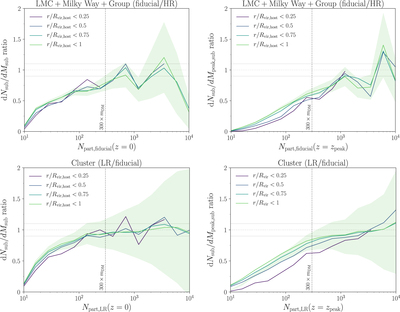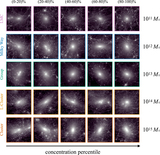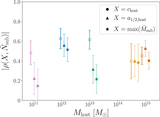Image Details

Caption: Figure 13.
Top-left panel: ratio of the mean differential subhalo mass function, evaluated using subhalo virial mass at z = 0, in 15 fiducial-resolution simulations (five from each of the LMC, Milky Way, and Group suites), normalized to that in high-resolution (HR) resimulations of these halos. Results are plotted in terms of equivalent particle number in the fiducial-resolution runs, i.e., N part,fiducial(z = 0) = M sub/m part,fiducial. Ratios are shown for subhalos within 0.25 (purple), 0.5 (blue), 0.75 (blue-green), and 1.0 (green) times the host halo virial radius in each fiducial or HR simulation. The green band indicates 1σ Poisson error on the mean for the result using all subhalos within the virial radius. Thin solid horizontal lines indicate ratios of ±10%, and curves are truncated when the error on the mean exceeds 100%. The vertical dashed line corresponds to our fiducial convergence limit of 300m part. Top-right panel: same as the top-left panel, but for differential peak subhalo mass functions. Note that a more stringent particle number threshold of N part,LR(z = z peak) ≳ 1000 is required to achieve a similar level of convergence in terms of M peak,sub for subhalos at large distances from the host center. Furthermore, the convergence properties of the M peak,sub function depend strongly on distance (see Appendix B.2 for details). Bottom-left panel: same as the top-left panel, but using subhalo mass functions from low-resolution (LR) resimulations of all 96 Cluster halos, normalized to those in our fiducial-resolution Cluster simulations and stacked over all hosts. Results are plotted in terms of equivalent particle number in the LR runs, i.e., N part,LR(z = 0) = M sub/m part,LR. Bottom-right panel: Same as the bottom-left panel, but for differential peak subhalo mass functions.
Copyright and Terms & Conditions
© 2023. The Author(s). Published by the American Astronomical Society.












